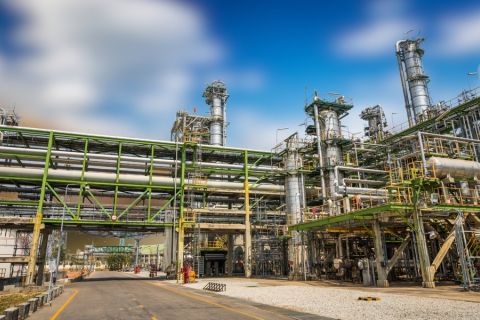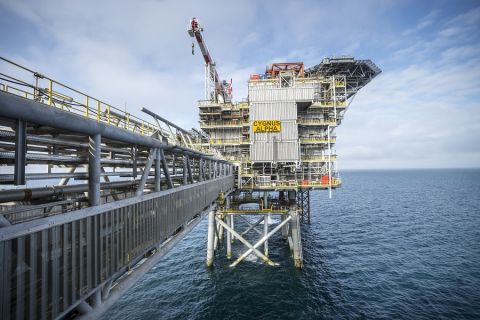Texas' Maverick Basin on the Rio Grande River has historically been underexplored due to its small scale and complex reservoirs. Adjacent to the well-known and heavily explored Gulf Coast Basin, a majority of the basin can be found in Maverick County. A small section also extends east into Dimmit County. Similar to the Gulf Coast Basin, Maverick is characterized by gently dipping beds, ranging in age from Jurassic to Cretaceous. It is known for its diverse stratigraphy. A range of carbonate, sandstone, coal and shale beds all show reserve potential, and companies have begun to explore most of these formations. Multiple reservoirs have both oil and gas reserves in place.
Recent exploration success by local operators is validating many concept plays, and gaining attention from larger E&P companies. New plays vary from coalbed methane to shale gas to tar sands. San Antonio-based small-cap TXCO Resources Inc., formerly known as The Exploration Co., holds more than 600,000 net acres in Maverick Basin, and is exploring more than 20 productive zones with thousands of potential drilling locations. Calgary-based super-independent EnCana Corp. recently labeled the basin an emerging play and has partnered with TXCO to explore the Pearsall shale there. Other players include Houston-based super-independent Anadarko Petroleum Corp., small-cap GeoResources Inc. via its Aroc Texas Inc. business unit, and privately held, Houston-based CMR Energy LP. Although individual projects in the basin have limited scale, the sum of their potential is beginning to raise its profile. Exploration is accelerating-drilling permits doubled in 2006. The basin is one of the few areas in the mature, heavily developed Gulf Coast region where operators can engage in new exploration.
Pearsall shale Maverick is a heavily faulted half-graben that presents operators with some of the region's most complex geology. Without the current advancements in 3-D seismic processing and directional drilling, this basin would likely remain too challenging to explore. Previous operational problems and low commodity prices led to under-development in the basin, a trait very uncharacteristic of the Gulf Coast region. Activity, as gauged by applications for drilling permits, has been rising as higher oil prices create increased cash flow to fund exploration. The largest land-holder in the Maverick Basin is TXCO, which has quickly grown its gross position to more than 600,000 acres. It has a firm exploration component in its strategy and has held leases in the basin since the 1980s. It has always maintained a strong interest in exploring all of the basin's formations. However, the company had difficulty executing its projects in the past because of capital constraints and challenging relationships with other operators. These issues have since been remedied, in part due to an infusion of capital through its new partnership with EnCana. The basin's unique sets of formations represent widely different depositional environments. Operators have not ruled out the potential of any of these reservoirs to date, but focus appears to be directed on four plays, and the largest upside resides in the Pearsall shale. The Pearsall blanket shale deposit occurs across the entire basin. TXCO was originally brought into Maverick because of this play, and the company holds shale acreage in the northern and central portions of the basin. EnCana holds shale acreage in the central portion, and Anadarko recently acquired acreage in the southern section. Initial production from the shale occurred in the 1980s when wells intersected natural fractures. Additional drilling did not intersect these fractures and development ceased. Now, completion and fracturing techniques perfected in the Barnett shale play are being implemented in the Pearsall
Oil, CBM plays Other plays are for Glen Rose porosity oil, San Miguel oil sands and Olmos coalbed methane (CBM). Glen Rose, discovered in 2001, is a carbonate reservoir that has produced nearly 4 million barrels of low-sulfur, light crude. The play is approximately 30 miles wide and situated in the southern portion of the basin. Oil accumulations are trapped in isolated, high-porosity carbonate pockets that were formed during volcanic events. 3-D seismic imaging is improving pay identification and oil production is steadily growing.
The San Miguel oil-sands play results from oil-sand programs piloted by ExxonMobil and ConocoPhillips in Maverick Basin in the 1970s and 1980s. The oil-sand deposit covers 170,000 acres in the northeastern portion. TXCO first attempted to produce from this play in 2006, but failed to sufficiently raise formation temperature. The company cites San Miguel as analogous to Cold Lake Field in Alberta's rich Athabasca oil-sands deposit. For the Olmos CBM play, TXCO enlisted the U.S. Geological Survey in 2000 to help assess the potential of coal deposits in the basin. Attention to CBM potential there was first raised when a retired manager with Pemex, Mexico's national oil company, discussed with TXCO management the Pemex CBM-venting operations in Mexico south of Maverick Basin. These bituminous coal deposits are up to 20 feet thick and could hold up to 1 trillion cubic feet of gas in place. Although abundant infrastructure exists, it remains to be determined if these coals can produce economically.
Production Production from Maverick County is largely by TXCO and ConocoPhillips. These two companies have long held positions in Maverick Basin and seem to be benefiting from experience and scale. TXCO's current growth play is the Glen Rose, while ConocoPhillips is holding its legacy oil production steady from San Miguel sands in Sacatosa Field. TXCO has interests throughout the basin, and through increased drilling, will likely continue to be its largest producer in the near term. ConocoPhillips built a position in Sacatosa in the 1950s and continues to steadily develop this water-drive field. During 2006, ConocoPhillips was granted 66 new drilling permits in Maverick County. Although activity and interest in the basin are rising, some of the emerging plays and new projects will not affect overall production in the near term. EnCana was granted one drilling permit in 2006, and Anadarko had filed for only two permits in first-half 2007. Even if these two operators achieve exploration success, any large-scale development project is years away. Therefore, recent trends in total oil and gas production from Maverick County should be an excellent indicator of near-term volumes. As for gas production in the basin, this has been declining since 1999, specifically in Prickly Pear Field. TXCO is the only operator in this field and it appears that natural reservoir depletion and the lack of additional drilling are contributing to the decline. Reduced gas output from Prickly Pear Field has been partially offset by gas-production growth in Chittim East Field by TXCO and Aroc Texas Inc. Overall, declining gas volumes have been offset by increasing oil production. On an equivalent basis, total production from the basin has been on the rise since 2004. Comanche-Halsell Field has shown aggressive growth via new projects by TXCO and CMR Energy. The emerging Glen Rose porosity oil play is the key reservoir in Comanche-Halsell Field.
Conclusion The Maverick Basin is showing increased potential. Production from the Glen Rose porosity oil play is growing, although oil prices will need to remain at or above current levels to support this development. TXCO, the largest operator in the basin, has recently secured additional capital and will be able to raise its level of exploration activity. ConocoPhillips has increased its number of permitted well locations in the area, a further bullish sign for oil production from the basin. Using technological advancements in both 3-D seismic processing and directional drilling, operators are better able to determine well locations and engineer completions. As they help operators explore the basin more effectively, these new applications will help reduce exploration risk. Successful independents EnCana and Anadarko have built sizeable positions in the basin where both companies are targeting Pearsall shale. EnCana has proven expertise in the Barnett shale and Anadarko's leasehold confirms rumors that the company has been quietly targeting shale plays. By the end of 2006, Anadarko had sunk costs of $61 million in its Maverick position. Anadarko and EnCana's access to capital is a tremendous asset in supporting development of the Pearsall shale. Although production is not expected to grow significantly in the short term, Maverick Basin shows promise. The combination of experienced operators, new capital and creative exploration prospects could help the basin develop into a significant regional producer.
Robert Clarke is an analyst, Gulf Coast upstream, in Houston for U.K.-based research firm Wood Mackenzie. He was previously a field geologist for a private engineering and consulting firm. He holds a bachelor's in geology from Texas A&M and received his MBA from the University of Arizona.
Recommended Reading
Weyerhaeuser, Lapis Energy Enter Carbon Sequestration Exploration Pact
2024-02-29 - The exploration agreement covers 187,500 acres across three states with five potential carbon sequestration sites.
Talos Energy Sells CCS Business to TotalEnergies
2024-03-18 - TotalEnergies’ acquisition targets Talos Energy’s Bayou Bend project, and the French company plans to sell off the remainder of Talos’ carbon capture and sequestration portfolio in Texas and Louisiana.
Eni, Vår Energi Wrap Up Acquisition of Neptune Energy Assets
2024-01-31 - Neptune retains its German operations, Vår takes over the Norwegian portfolio and Eni scoops up the rest of the assets under the $4.9 billion deal.
Marketed: Anschutz Exploration Corp. WI Opportunity in Converse County, Wyoming
2024-01-26 - Anschutz Exploration Corp. retained EnergyNet for the sale of its WI participation option in Converse County, Wyoming.
Excelerate Energy, Qatar Sign 15-year LNG Agreement
2024-01-29 - Excelerate agreed to purchase up to 1 million tonnes per anumm of LNG in Bangladesh from QatarEnergy.




